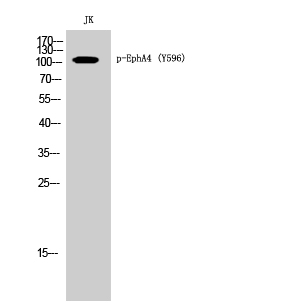EphA4 (phospho Tyr596) Polyclonal Antibody
- Catalog No.:YP0507
- Applications:WB;ELISA
- Reactivity:Human;Mouse
- Target:
- EphA4
- Fields:
- >>Axon guidance
- Gene Name:
- EPHA4
- Protein Name:
- Ephrin type-A receptor 4
- Human Gene Id:
- 2043
- Human Swiss Prot No:
- P54764
- Mouse Gene Id:
- 13838
- Mouse Swiss Prot No:
- Q03137
- Immunogen:
- Synthesized phospho-peptide around the phosphorylation site of human EphA4 (phospho Tyr596)
- Specificity:
- Phospho-EphA4 (Y596) Polyclonal Antibody detects endogenous levels of EphA4 protein only when phosphorylated at Y596.
- Formulation:
- Liquid in PBS containing 50% glycerol, 0.5% BSA and 0.02% sodium azide.
- Source:
- Polyclonal, Rabbit,IgG
- Dilution:
- WB 1:500 - 1:2000. ELISA: 1:10000. Not yet tested in other applications.
- Purification:
- The antibody was affinity-purified from rabbit antiserum by affinity-chromatography using epitope-specific immunogen.
- Concentration:
- 1 mg/ml
- Storage Stability:
- -15°C to -25°C/1 year(Do not lower than -25°C)
- Other Name:
- EPHA4;HEK8;SEK;TYRO1;Ephrin type-A receptor 4;EPH-like kinase 8;EK8;hEK8;Tyrosine-protein kinase TYRO1;Tyrosine-protein kinase receptor SEK
- Observed Band(KD):
- 110kD
- Background:
- This gene belongs to the ephrin receptor subfamily of the protein-tyrosine kinase family. EPH and EPH-related receptors have been implicated in mediating developmental events, particularly in the nervous system. Receptors in the EPH subfamily typically have a single kinase domain and an extracellular region containing a Cys-rich domain and 2 fibronectin type III repeats. The ephrin receptors are divided into 2 groups based on the similarity of their extracellular domain sequences and their affinities for binding ephrin-A and ephrin-B ligands. Multiple transcript variants encoding different isoforms have been found for this gene. [provided by RefSeq, Jan 2015],
- Function:
- catalytic activity:ATP + a [protein]-L-tyrosine = ADP + a [protein]-L-tyrosine phosphate.,domain:The protein kinase domain mediates interaction with NGEF/ephexin-1.,function:Receptor for members of the ephrin-A family. Binds to ephrin-A1, -A4 and -A5. Binds more poorly to ephrin-A2 and -A3. May play a role in a signal transduction process involved in hindbrain pattern formation.,similarity:Belongs to the protein kinase superfamily. Tyr protein kinase family.,similarity:Belongs to the protein kinase superfamily. Tyr protein kinase family. Ephrin receptor subfamily.,similarity:Contains 1 protein kinase domain.,similarity:Contains 1 SAM (sterile alpha motif) domain.,similarity:Contains 2 fibronectin type-III domains.,subunit:Interacts with the src family kinase, p59-Fyn, through the major phosphorylation site at position Tyr-602. Interacts with NGEF/ephexin-1.,tissue specificity:Ubiquitous.
- Subcellular Location:
- Cell membrane ; Single-pass type I membrane protein . Cell projection, axon . Cell projection, dendrite . Cell junction, synapse, postsynaptic density membrane . Early endosome . Cell junction, adherens junction . Clustered upon activation and targeted to early endosome. .
- Expression:
- Ubiquitous.
- June 19-2018
- WESTERN IMMUNOBLOTTING PROTOCOL
- June 19-2018
- IMMUNOHISTOCHEMISTRY-PARAFFIN PROTOCOL
- June 19-2018
- IMMUNOFLUORESCENCE PROTOCOL
- September 08-2020
- FLOW-CYTOMEYRT-PROTOCOL
- May 20-2022
- Cell-Based ELISA│解您多样本WB检测之困扰
- July 13-2018
- CELL-BASED-ELISA-PROTOCOL-FOR-ACETYL-PROTEIN
- July 13-2018
- CELL-BASED-ELISA-PROTOCOL-FOR-PHOSPHO-PROTEIN
- July 13-2018
- Antibody-FAQs
- Products Images

- Western Blot analysis of JK cells using Phospho-EphA4 (Y596) Polyclonal Antibody



